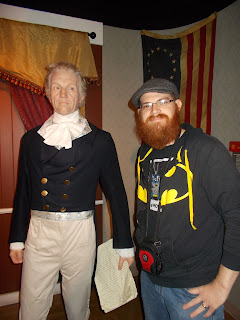 On our third and final day in Washington DC my wife
and I managed to find two extremes to a problem in the museum world. We visited the National Archives! Yes, I
finally was able to see the location of the presidential papers of Woodrow
Wilson (although I did not actually see any of his papers). Leah and I
were awed to see the Bill of Rights, the Declaration of Independence and of
course the Constitution. However, there was absolutely NO photography allowed.
Photography can be both the best friend to the museum and their greatest foe.
Particularly flash photography.
On our third and final day in Washington DC my wife
and I managed to find two extremes to a problem in the museum world. We visited the National Archives! Yes, I
finally was able to see the location of the presidential papers of Woodrow
Wilson (although I did not actually see any of his papers). Leah and I
were awed to see the Bill of Rights, the Declaration of Independence and of
course the Constitution. However, there was absolutely NO photography allowed.
Photography can be both the best friend to the museum and their greatest foe.
Particularly flash photography.
The National Archives had a no photography policy and
in the rooms where the Constitution was held they had very soft lighting (just
light enough so you wouldn’t trip). This
was explained by security guards and a number of signs that the bright lights
of a camera’s flash or a few thousand flashes would damage the documents in
question. If one doubted this all they would have to do is simply look at the
Constitution and see the faded words that years of being proudly displayed in
the sun. As I started writing this post
I wanted to submit some sources so people could see that the no photography rule
was not a gimmick to get visitors to buy more post cards (actually I don’t
remember seeing any post cards in the gift shop). It was actually a little harder that I would
have thought because google was full of blog posts that said such rules were
just scams and it didn’t matter if you used flash or not (most of these posts
were referring to art work and not historical documents). In order to protect historical artifacts
curators must control as many environmental factors as they can, that is why
flash photography is often prohibited, why artifact cases have environmental
controls to control the temperature are installed. Simple things like heat, light and even air
can damage a large array of items including paper, ink, paints, dyes, metals,
fabrics and leather products (oxygen is super corrosive, if I were more
science-y I would tell you how that works but I’m not). These are some of the articles I looked up:
http://www.straightdope.com/columns/read/1783/why-isnt-flash-photography-permitted-in-museums
http://www.getty.edu/conservation/publications_resources/pdf_publications/pdf/aging.pdf
http://www.artnews.com/2013/05/13/photography-in-art-museums/
http://www.ccaha.org/uploads/media_items/light-exposure-of-artifacts-on-exhibition.original.pdf
The Archives offered one extreme of the no photography
rule while my and Leah’s next stop offered the exact opposite extreme. We
visited Madame Tussaud's Wax Museum in Washington DC, where you are free take
as many pictures as you like. The person who sold us our tickets actually
told to "take lots of pictures." I confess this was the best part for me
because I got to be a little silly and then share all my pictures on social
media. Now, I know what you’re thinking
"Madame Tussaud's is not a historical museum!" Actually, it has
a very long history of entertaining tourist with 23 locations all over the
world and the 24th to open in New Delhi next year. But I'm more concerned about
the Wax museum as an education tool for American History. The Washington
DC location contains wax figures of all 44 presidents as well as civil rights
activists Martin Luther King, Malcom X and Rosa Parks. It also allowed for me
and Leah to take pictures with a couple of our favorite musicians.
It was about
the time I was giving Leah a piece of presidential trivia about William Howard
Taft that I realized that walking through a room with life sized models of
these historical figures was just as educational as any of the museums we had
visited previously. I have been asked
several times, “if I could have lunch with any historical figure who would that
be?” Leah and I had the next best thing, “if you could take a selfie with a
historical figure who would that be?”
History can be a lot of fun.



I'm a historian and a museum employee, so of course
museums are fantastic to me but let’s face it there are those who are less
nerdy than I, or at least nerdy in different ways. Which means fun has to
be in the equation, especially if a museum wants to stay open. Part of the fun of any road trip is the
pictures, for a museum this can become a conundrum, museums must protect
artifacts like papers, photos, fabrics and leathers, all materials that can be
damaged by flash photography over time. But,
in the world of Facebook, Twitter, and Instagram pics are a must for any trip. Museums
today have to display a balance to stay relevant (open and operating), they
must protect their artifacts and make it fun for visitors.








No comments:
Post a Comment